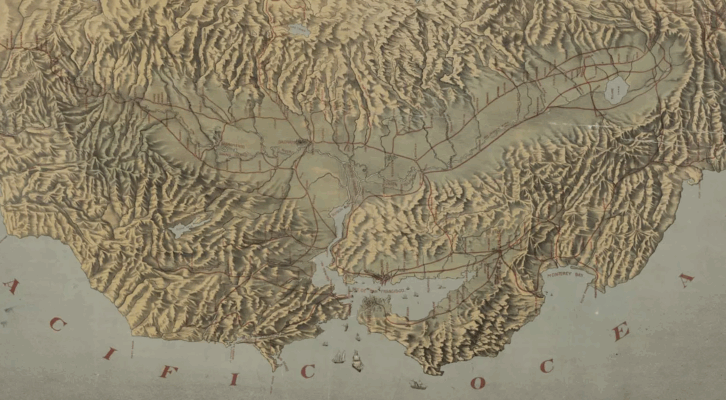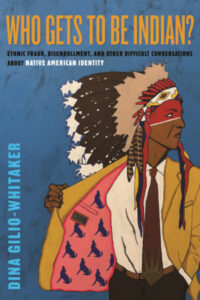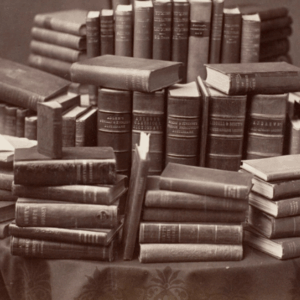
How California’s Legacy of Violence Against Indigenous People Impacts the Present Day
Dina Gilio-Whitaker Unpacks the Complexities Surrounding Native Authenticity
In June 2019, the Los Angeles Times published an exposé revealing that companies had secured over $300 million in government contracts based on wrongful claims to Cherokee heritage since 2000. The authors looked at fourteen companies, twelve of which cited ties to three fraudulent Cherokee tribes—the Northern Cherokee Nation, the Western Cherokee Nation of Arkansas and Missouri, and the Northern Cherokee Nation of the Old Louisiana Territory, all in Missouri, where there are no federal or state recognized tribes.
Although research found no legitimate documentation of Native American ancestry for any of the companies’ owners, they obtained multimillion dollar contracts under federal, state, and municipal programs for minority businesses spanning eighteen states, and they were all registered as Native American-owned businesses with the federal Small Business Administration.
One of the article’s authors, Adam Elmahrek, explained in a video embedded within the online article that the investigation started with a tip the newspaper received that William Wages, brother-in-law of House Minority Leader and later ousted Speaker of the House Kevin McCarthy (R-Bakersfield), was the owner of one of the twelve companies with fraudulent Cherokee claims.
Violence against Indigenous people is woven into the cultural DNA of California, and though much of the operationalized violence via policy has been left in the past, its legacy lingers in the present.
Later that year, the Los Angeles Times published another story exposing Native American identity fraud in Southern California. By following the money, the article probed the Chumash identity claims of Mati Waiya, CEO and president of the Malibu-based Wishtoyo Chumash Foundation. The article underscored that the nonprofit had raised more than $12 million since 2015 after engaging in legal battles to protect Chumash cultural sites and waterways from polluting development projects, highlighting that it employed several family members, all of whom claimed to be Chumash.
There is only one federally recognized Chumash tribe, the Santa Ynez Band of Chumash Indians, with a reservation in inland Santa Barbara County. But there are several non-federally recognized Chumash groups in the coastal region with varying degrees of legitimacy. Mati Waiya, whose birth name is Frank Rocha, is a controversial figure, stemming primarily from his Chumash claims. Waiya/Rocha is known for his unusual appearance, sporting a bone piercing through his nose and dressing in elaborate coastal Indian regalia as a “ceremonial leader.” This has sometimes led to accusations of inauthenticity and performative behavior by Chumash and other Southern California Indian people.
Waiya is backed by current and past members of Wishtoyo Chumash Foundation’s board of directors, including actors Beau Bridges and Max Gail, University of California, Los Angeles, law professor Carole Goldberg, and LA County Superior Court judge Deborah Sanchez. Wishtoyo has been funded by the Leonardo DiCaprio Foundation, the Baltoro Family Trust (Yvon Chouinard Family Trustees), Edison International, California Department of Fish and Wildlife, Marisla Foundation (created by heirs to the Getty oil fortune), San Manuel Band of Mission Indians, Resources Legacy Fund, Center for Biological Diversity, among others.
The Los Angeles Times examined Waiya’s genealogy with the help of an expert on Chumash ethnohistory and genealogy, Dr. John Johnson. Johnson recalled that Waiya’s cousin had contacted him in the late 1990s for help establishing the family’s indigenous lineage and “were disappointed that we didn’t find any Chumash ancestry.”
When asked about the newspaper’s findings, Waiya responded that his detractors “[are] submissive to a genocidal, colonial thinking that’s destroyed our people… We don’t have to prove this… They’re not the Chumash police or the Chumash God” and that they could “take us to court.” His supporters, including law professor Goldberg, were dismissive of the lack of documentation for Waiya’s Chumash claims.
The case of Mati Waiya and his contested Chumash identity opens the door to a bigger conversation about California as a site where American Indian identity issues have played out in particularly disturbing ways. With the largest population of Native Americans in the US, California has more tribes, federally recognized and non-recognized, than any other state. The state also has the unfortunate distinction of being the epicenter of both modern pretendianism and tribal disenrollment.
The broader history of California is the context for the troubling Native identity issues we see today. The violent foundation laid by the Spanish through the cruelties of the mission system in the latter eighteenth century continued through three colonial periods, including the brief secularized Mexican era, and intensified in the American period. From the inception of the mission system, settlers of early California declared their commitment to the extermination of Indigenous populations, as proclaimed in the first state-of-the-state address given by Governor Peter Burnett in 1851.
Even after California Indian populations were decimated by disease and the genocidal gold rush, a sweeping state law misleadingly named the Act for the Government and Protection of Indians, which had passed in 1850, confined California Indians to indentured servitude to white settlers and led to twenty-seven other laws funding militia-driven killing sprees (“expeditions against the Indians”) from 1851 to 1859, at a cost of $1.3 million.
The law preceded the federal policy of assimilation through the boarding school system and land allotment, constituting a sustained genocidal attack on California Indian communities at the state and federal level over a period of at least eighty years. Land theft was normalized through the suppression of eighteen treaties federal agents negotiated with California tribes between 1851 and 1852. The treaties were never ratified by the Senate and were subsequently concealed for decades.
Violence against Indigenous people is woven into the cultural DNA of California, and though much of the operationalized violence via policy has been left in the past, its legacy lingers in the present. Its impacts can be seen in multiple ways, from the miniscule size of reservations, often called “rancherias,” to the number of tribes that were terminated in the 1950s and remain federally unrecognized.
As the dust settles from centuries of colonial violence, tribal communities find themselves in various stages of cultural recuperation. Some are more intact than others, and a few cling to not much more than remnants of their pre-contact existence.
All the public knew were the portrayals Hollywood’s fantasy-driven film industry showed them—Indians who were always tragically vanishing, almost always depicted as buckskin-clad Plains Indians, and typically played by impersonators.
Especially hard-hit were the tribes in the most populous areas of the Los Angeles and San Francisco basins. In these areas, where indigenous lands have been transformed into some of the world’s most valuable real estate, there are no federally recognized tribes. In the areas of Orange County, Los Angeles, Santa Barbara, and San Luis Obispo, several bands of Chumash, Tongva/Gabriellino, Tataviam, and Acjachemen/Juaneño still assert their tribal existence, as do several bands of Ohlone and Costanoan people in the broader San Francisco Bay Area.
Some have vied and failed to meet the criterion of the federal acknowledgment process. Many of these groups began reemerging in the mid-twentieth century and continue to pop up in this century, leading to the term pop-up tribes, sometimes used to describe neo-Indian groups. While these tribes and individuals still exist, California is an ethnically cleansed landscape where systematic erasure has rendered them largely invisible.
By the early twentieth century, the general public assumed that there were no California Indians left, leaving a void of perceivable authentic indigeneity. All the public knew were the portrayals Hollywood’s fantasy-driven film industry showed them—Indians who were always tragically vanishing, almost always depicted as buckskin-clad Plains Indians, and typically played by impersonators.
Into this liminal space would step actual Native people, those who believed they might have California Indian or other Native American heritage, and imposters. Telling them apart is the challenge contemporary pretendianism presents, and arguably, nowhere is the problem more acute than in California.
California has long been a place people have come to seek their fortunes and reimagine themselves. For some, it is a place to find themselves, and for others, it is a place to hide. Beyond the weather, it’s the unique brand of bohemian exoticism that draws people in. Studies on bohemian culture offers some useful insights. A rich literature traces modern bohemianism’s emergence initially to mid-nineteenth-century France from where it travels to the United States, with roots in New York and California. Early American bohemianism is often associated with the literature of Edgar Allan Poe, Mark Twain, Walt Whitman, Jack London, and Henry Miller, as well as a host of artists and intellectuals who embraced social nonconformity through a rejection of mainstream bourgeoisie values.
In post-World War II, America bohemianism is most recognizable in the Beat generation, the precursor of the hippie counterculture. Studies on bohemianism tend to emphasize the primacy of cities, where radical and eclectic ideas were shared through newspapers, literary periodicals, coffeehouses, bars, cafés, bookstores, and art galleries.
More recent scholarship, however, shows California’s brand of bohemian culture evolving differently from New York’s, especially in Southern California. Here, bohemianism became more culturally and geographically diverse as it migrated to beach landscapes, forming ties to the budding surfing subculture of the 1920s. Numerous bohemian, and counterculture, enclaves dotted the Los Angeles area from the late nineteenth century centered in Arroyo Seco, Echo Park/Silverlake, Laurel Canyon, and Laguna Beach. Several were—and still are—located within the historic Chumash areas of Malibu, Topanga Canyon, Santa Barbara, and San Luis Obispo.
The Beat generation was predominantly a white literary and art movement that drew inspiration (some would say culturally appropriated) from Black culture, music and jazz in particular. Like the earlier bohemian culture, the Beat movement traces its origins to New York and later established connections in San Francisco. Pushing the American cultural envelope, the Beats sought freedom from oppressive conventional social mores that could be found not only in relaxed censorship laws but in sexual liberation, drug use, and other unconventional thinking and behavior.
Many Beats veered into the realm of religion and spirituality in their quest for a more authentic and liberated American identity. Although the literature on Beat religion and spirituality is sparse, Beat writers like Jack Kerouac, Diane DiPrima, Allen Ginsberg, and Gary Snyder were well-known for their contemplations on Christianity, Buddhism, and other religious traditions, including Native American spirituality and culture. Kerouac, for instance, invoked Indians in the countercultural classics On the Road and The Dharma Bums as foils against crass American modernity but also in ways that just reconfigured the old tropes of noble savages and reinforced American settler discovery mythologies of rugged individualism, freedom, and rebellion.
The Religious Crimes Code criminalizing Indian spiritual practices and church-run boarding schools did its work to ensure Indian children were cut off from their spiritual traditions.
The poet Gary Snyder, who had a degree in anthropology and was deeply influenced by the study of Northwest tribal cultures, became a prominent environmentalist, bridging the Beat generation and later the back-to-the-land movement. Alternative and new religious movements had long taken root in the US, with numerous branches leaning toward mysticism, metaphysics, and the occult. In the 1950s, American Indian spirituality and politics would encounter metaphysical practitioners in strange and unpredictable ways.
Meanwhile, in Indian country, tribes were still adapting to the governance structures of the Indian Reorganization Act (IRA) of 1934, and with decades of assimilation and cultural breakdown, many reservation communities became fractured. Tribal tensions were exacerbated in some places by growing environmental problems caused by dam building, mining, and other extractive and polluting processes, and by 1953, termination.
It was also a time of concerted efforts to restore traditions, as Indians worked to reverse the cultural erosion caused by missionaries and the federal government. The Religious Crimes Code criminalizing Indian spiritual practices and church-run boarding schools did its work to ensure Indian children were cut off from their spiritual traditions. The religious ban would not be formally repudiated until the American Indian Religious Freedom Act of 1978.
In the mid-twentieth century, Indian religious suppression was not as severe as it had been, but the damage from the combined heavy-handed tactics of the federal government and churches had been done. From the 1940s to the 1960s, an emerging tribal traditionalist movement began calling for reconciliation between Native religions and Christianity and intertribal unity. Over several decades, their well-intentioned efforts were met with limited success, but the questionable actions of one group of traditionalists would lead to unintended consequences that Native people live with today.
__________________________________

Excerpted from Who Gets to Be Indian?: Ethnic Fraud, Disenrollment, and Other Difficult Conversations About Native American Identity by Dina Gilio-Whitaker. Copyright 2025. Excerpted with permission by Beacon Press.
Dina Gilio-Whitaker
Dina Gilio-Whitaker (Colville Confederated Tribes) is a lecturer of American Indian Studies at California State University San Marcos, and an independent consultant and educator in environmental justice policy planning. At CSUSM she teaches courses on environmentalism and American Indians, traditional ecological knowledge, religion and philosophy, Native women’s activism, American Indians and sports, and decolonization. She also works within the field of critical sports studies, examining the intersections of indigeneity and the sport of surfing. As a public intellectual, Dina brings her scholarship into focus as an award-winning journalist as well, contributing to numerous online outlets including Indian Country Today, the Los Angeles Times, High Country News and many more. Dina is co-author with Roxanne Dunbar-Ortiz of Beacon Press’s “All the Real Indians Died Off”: And 20 Other Myths About Native Americans, and As Long as Grass Grows: The Indigenous Fight for Environmental Justice from Colonization to Standing Rock.



















